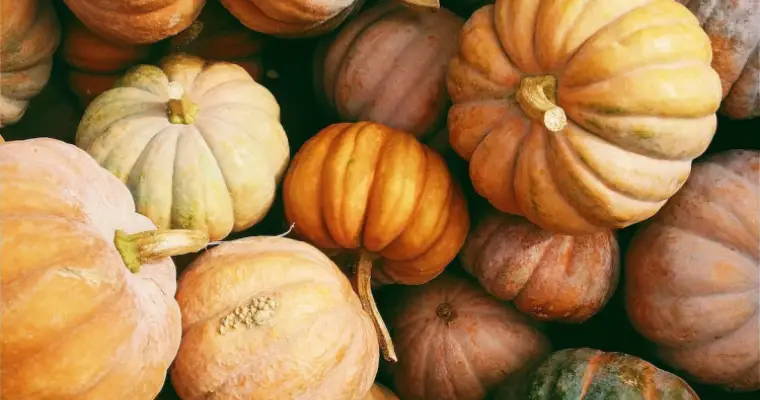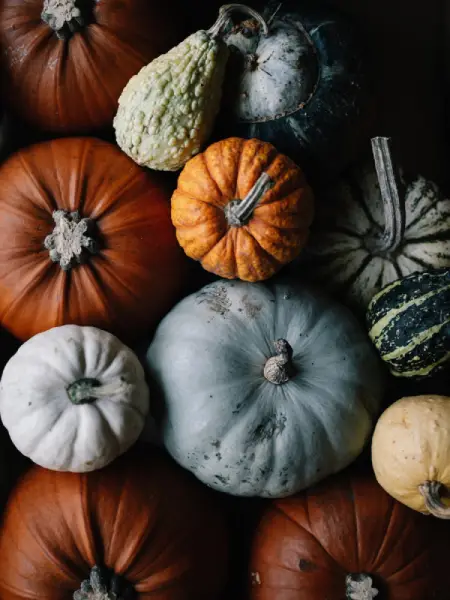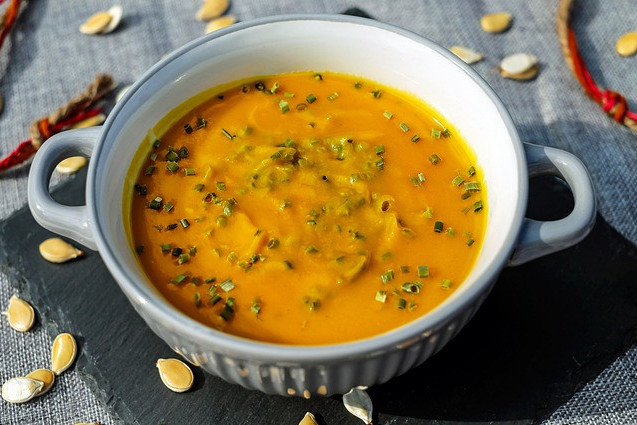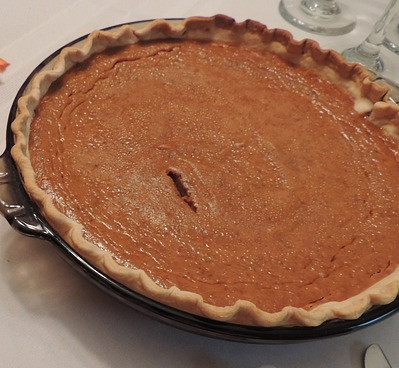Interesting Facts about Pumpkins

Pumpkins, known for their vibrant orange color and rich earthy flavor, have a long-standing association with the fall season. In this post, we’ll delve into interesting facts about pumpkins that might catch you by surprise.
The pumpkin with its rich history and versatile nature is not merely a symbol of the season. However, a nutritional powerhouse with a story that spans centuries.
Pumpkins are not only a symbol of fall but to us a symbol of health and flavor.
With their incredible nutritional benefits and versatility in recipes they deserve a prominent place in your Whole Food Plant-Based diet.
Rich Heritage of Pumpkins
It’s essential to understand their origin and historical significance, especially for those embracing a plant-based lifestyle.
Pumpkins, known scientifically as Cucurbita pepo, have an ancient history deeply intertwined with the Americas.
Native American Origins
Indigenous peoples in North and Central America cultivated pumpkins for thousands of years, and it’s believed that pumpkins had their origin there.
The word “pumpkin” itself has its roots in the Greek word “pepon,” which means “large melon.”
These early pumpkins differed from modern varieties. They were smaller, less uniform in shape, and often had varying colors.
Native Americans valued them for their adaptability, using pumpkins as a vital part of their daily life.
European Encounter
When European settlers arrived in the Americas, they encountered the diverse world of pumpkins.
The Native American pumpkin recipes quickly found their way into the settlers’ kitchens.
Specifically, pumpkins along with corn and beans became vital components of early American diets.
Worldwide Spread
Pumpkins also expanded their reach beyond the Americas, as explorers and traders transported pumpkin seeds to Europe, Asia, and Africa.
Over time, as they acclimated to various climates and regions, pumpkins underwent changes, resulting in the diverse array of varieties we recognize today.
However, the exact number of pumpkin varieties globally is challenging due to the wide range of local and heirloom varieties.
Below, you’ll find a list of the most commonly used pumpkin varieties.
Sugar Pumpkin (Cucurbita pepo var. saccharata):
Also known as pie pumpkins these small, sweet pumpkins are ideal for making pumpkin pies and other desserts.
Butternut Squash (Cucurbita moschata):
While not a traditional pumpkin, butternut squash often serves as an interchangeable ingredient in recipes. It has a sweet, nutty flavor and smooth texture, making it great for soups and purees.
Acorn Squash (Cucurbita pepo var. turbinata):
These small, acorn-shaped squashes have a mild, slightly sweet flavor and often roasted and stuffed.
Kabocha Squash (Cucurbita maxima):
With its dark green skin and vibrant orange flesh, kabocha squash has a sweet and nutty flavor. It’s ideal for soups, curries, and roasting.
Cinderella Pumpkin (Cucurbita pepo):
This French heirloom pumpkin, also referred to as Rouge Vif d’Etampes, boasts deep ribbing and bears a striking resemblance to Cinderella’s carriage pumpkin. It finds its way into both sweet and savory dishes.

Jarrahdale Pumpkin (Cucurbita maxima):
This Australian variety has a distinctive blue-gray skin and sweet, nutty flesh. Often used for roasting, baking, or pureeing.
Musque de Provence (Cucurbita moschata):
Originating in France, this pumpkin has a rich sweet flavor and is great for making pies, soups, and casseroles.
Lumina Pumpkin (Cucurbita pepo):
Lumina pumpkins are white and provide a unique twist on traditional pumpkin dishes.
Typically, people use it for decorative purposes and in recipes when they desire a contrasting color.
Long Island Cheese Pumpkin (Cucurbita moschata):
This heirloom pumpkin, resembling a wheel of cheese, earns recognition for its sweet, smooth flesh. People favor it for crafting pies and soups.
Jack-o’-Lantern (Cucurbita pepo):
This classic orange pumpkin, renowned for its round shape, primarily serves as the choice for carving during October.
These are just a few of the many pumpkin varieties that people cultivate and enjoy worldwide.
Also, each variety brings its own distinct flavor and texture to a wide range of culinary creations, making pumpkins a versatile and beloved kitchen ingredient.
Be sure to sign up for your > Free 12 Tips Food Guide <
Pumpkin Nutrition Facts
Pumpkin is often considered highly nutritious, though it’s not typically categorized as a “superfood” like kale or blueberries.
Nonetheless, its health benefits make it a valuable addition to a balanced diet. Pumpkin’s reputation as a nutritious choice stem from several factors
Rich in Vitamins and Minerals:
Pumpkin provides essential vitamins and minerals. It’s particularly high in vitamin A vital for eye health, and offers B vitamins, vitamin C, vitamin E, and crucial minerals like potassium and manganese.
High in Fiber:
Pumpkin contains relatively high dietary fiber, promoting digestive health.
Fiber regulates bowel movements, supports gut bacteria, and aids weight management by inducing a sense of fullness.
Low in Calories:
Pumpkin is calorie-efficient, making it suitable for calorie-conscious individuals. A cup of cooked, mashed pumpkin contains fewer than 50 calories.
Antioxidant Properties:
Pumpkins feature antioxidants, including beta-carotene, guarding cells against free radical damage. Beta-carotene converts to vitamin A, benefiting immune function and skin health.
Healthy Carbohydrates:
Pumpkin’s carbohydrates primarily comprise complex carbs, offering sustained energy without causing rapid blood sugar spikes.
Versatility in Cooking:
Pumpkin’s culinary adaptability shines. It seamlessly fits into both sweet and savory dishes, enhancing soups, stews, pies, smoothies, and more, promoting dietary diversity.
Pumpkin Nutrition Facts in a Nutshell
- 1 cup of cooked, mashed pumpkin has only 49 calories.
- It contains 200% of your daily vitamin A needs.
- A good source of potassium, aiding in heart health.
- Provides 2.7 grams of fiber per cup, promoting digestive health.
- Offer a hearty dose of vitamins like A, C, and E. These vitamins strengthen your immune system, boost collagen production, and combat free radicals for glowing skin.
Furthermore, the pumpkin’s impressive nutritional profile contributes to its reputation as a nutritious choice. Remember, a well-rounded diet should incorporate various fruits, vegetables, and whole foods to access a wide range of nutrients and health benefits.
Upcoming Culinary Delights
Get ready to savor our Whole Food Plant-Based pumpkin pie and a wonderful pumpkin curry dish, both packed with wholesome goodness.
Stay tuned for these delightful recipes that celebrate the rich flavors of pumpkin in a nutritionally conscious way.
Conclusion
As you can see, there’s much more to pumpkins than their role as fall decorations or pie fillings.
Also, their rich history, diversity, nutritional value, and versatility in the kitchen make them a fascinating and important part of our culinary and cultural heritage.
So, the next time you enjoy a slice of pumpkin pie or a spoon full of pumpkin curry, you can appreciate the hidden depths of this beloved fall fruit.
Pumpkins truly are a symbol of the season’s bounty and the intriguing world of nature’s wonders.
Be sure to sign up for your > Free 12 Tips Food Guide <
Please leave us a comment if you enjoyed our exploration of the Interesting Facts about Pumpkins.
Cheers,
Plantaful Life Team
Disclaimer: The information shared in this blog post and on our website is for educational and informational purposes only. We are here to inspire and support you on your plant-based journey. However, always prioritize your health and consult with your trusted healthcare provider for personalized advice. By using our website, you acknowledge and agree that you have read and understood this medical disclaimer. Additionally, you acknowledge the significance of seeking professional medical advice for your specific health needs.
References:
Easy Recipe for Pumpkin Pie – Plantaful Life
Cleveland Clinic


I find this article on pumpkins very interesting. I did not know that there were so many different types of pumpkins. I don’t eat pumpkins often, but when I do, I like it in soup. In the Caribbean, we often put pumpkins in our soup for the taste and the beautiful color–very tasty in chicken soup.
Hello Kay,
We are so glad you found our article interesting!
Pumpkins can be a year-round food and especially good in soups or curries.
Check out our recipe section for delightful pumpkin dishes.
Cheers Plantaful life
I have always loves pumpkins and now I have even more reason too! This is a great post to come across during Pumpkin Spice Season. The thing that stuck out to me the most about your post is that all those squashes and pumpkins you see being used as decorations are actually editable. We can eat them!!
Thank you for this info. I cannot wait to share the knowledge I just gained with family around the Thanksgiving table.
Thanks again,
G.Mack
You are welcome, glad you found the post insightful.
Yes, pumpkins are more than just decoration a truly wonderful addition to any diet.
Check out our recipe section for delightful pumpkin dishes.
Cheers Plantaful life
Pumpkins are so much more than just a symbol of fall – they have a rich history and incredible versatility. Learning about their origins with Native American cultivation and their journey to becoming a global culinary ingredient is fascinating. Plus, their nutritional value is impressive, with high levels of vitamins and fiber. Thanks for sharing these eye-opening pumpkin facts! ??